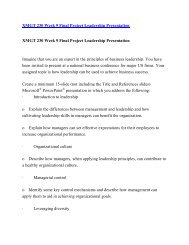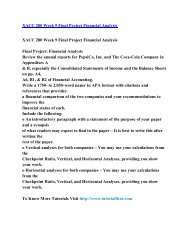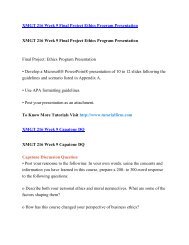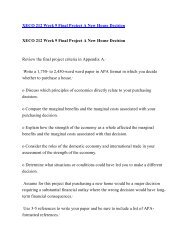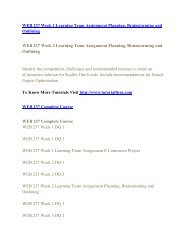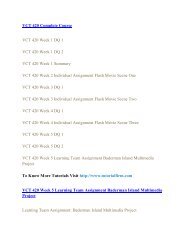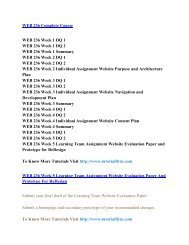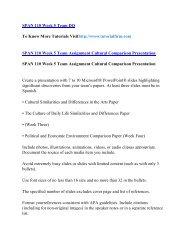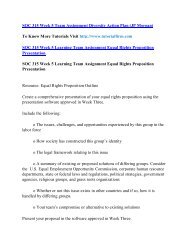HCP 220 UOP Course,HCP 220 UOP Materials,HCP 220 UOP Homework
You also want an ePaper? Increase the reach of your titles
YUMPU automatically turns print PDFs into web optimized ePapers that Google loves.
<strong>HCP</strong> <strong>220</strong> Week 9 Capstone DQ<br />
<strong>HCP</strong> <strong>220</strong> Week 9 Capstone DQ<br />
If you were compiling a pharmaceutical-calculation training manual to assist new<br />
pharmacy technicians, what two best practices would you emphasize that you<br />
learned in this course? Explain your answer.<br />
To Know More Tutorials Visit http://www.tutorialfirm.com<br />
<strong>HCP</strong> <strong>220</strong> Week 8 Individual Assignment Dosage, Flow Rates, Pediatric Drugs<br />
<strong>HCP</strong> <strong>220</strong> Week 8 Individual Assignment Dosage, Flow Rates, Pediatric Drugs<br />
Resources: Ch. 11–12 of Pharmaceutical Calculations for Pharmacy Technicians:<br />
A Work text<br />
Show all your calculations in a Microsoft® Word document<br />
Calculate appropriate dosages and flow rates for IV medications in the following<br />
exercises:<br />
· Stop and Review, p. 137: Problems 1a & 1d. Hint: Refer to the drug<br />
products label on pp. 135–136<br />
· Test Your Knowledge, pp. 147: Problem 30<br />
· Critical Thinking, p. 147: Problem 1<br />
· Stop and Review, p. 151: Problems 1e & 1f<br />
· Stop and Review, p. 152: Problem 2c
· Test Your Knowledge, p. 162: Problems 17 & 18<br />
· Critical Thinking, p. 163: Problem 1<br />
Post your work and answers as an attachment under the Assignment link along<br />
with a signed copy of the Certificate of Originality.<br />
To Know More Tutorials Visit http://www.tutorialfirm.com<br />
<strong>HCP</strong> <strong>220</strong> Week 8 CheckPoint IV Equipment<br />
<strong>HCP</strong> <strong>220</strong> Week 8 CheckPoint IV Equipment<br />
Resource: Ch. 11 of Pharmaceutical Calculations for Pharmacy Technicians: A<br />
Worktext and Appendix E<br />
Complete this activity by using Appendix E.<br />
Match various types of IV equipment with their definitions.<br />
To Know More Tutorials Visit http://www.tutorialfirm.com<br />
<strong>HCP</strong> <strong>220</strong> Week 7 DQ 2<br />
<strong>HCP</strong> <strong>220</strong> Week 7 DQ 2<br />
As a pharmacy technician, how would you determine the most suitable equipment<br />
to use in the administration of injectable medication? Provide examples.<br />
To Know More Tutorials Visit http://www.tutorialfirm.com
<strong>HCP</strong> <strong>220</strong> Week 7 DQ 1<br />
<strong>HCP</strong> <strong>220</strong> Week 7 DQ 1<br />
What are some of the advantages and disadvantages of using parenteral or<br />
injectable forms of medication compared to oral dosage forms? What additional<br />
considerations must you keep in mind when dispensing medication?<br />
To Know More Tutorials Visit http://www.tutorialfirm.com<br />
<strong>HCP</strong> <strong>220</strong> Week 6 Individual Assignment Amount Of Medication To<br />
Administer<br />
<strong>HCP</strong> <strong>220</strong> Week 6 Individual Assignment Amount of Medication to Administer<br />
Resources: Ch. 8 of Pharmaceutical Calculations for Pharmacy Technicians: A<br />
Work text and Appendix C<br />
Refer to Exercise 2 on p. 76 for a worked example.<br />
Determine the amount of medication to administer.<br />
Utilize the table in Appendix C to complete this assignment.<br />
To Know More Tutorials Visit http://www.tutorialfirm.com<br />
<strong>HCP</strong> <strong>220</strong> Week 6 CheckPoint Converting Dosages To Doses<br />
To Know More Tutorials Visit http://www.tutorialfirm.com
<strong>HCP</strong> <strong>220</strong> Week 5 DQ 2<br />
<strong>HCP</strong> <strong>220</strong> Week 5 DQ 2<br />
What are the essential components of a prescription order? In what ways do<br />
computers ensure accurate filling and dispensing of prescriptions? What existing or<br />
potential technological advances might make pharmacy technology a more<br />
accurate and safe practice?<br />
Remember to structure your response into paragraphs with correct<br />
spelling/grammar and meeting the 150-word minimum.<br />
To Know More Tutorials Visit http://www.tutorialfirm.com<br />
<strong>HCP</strong> <strong>220</strong> Week 5 DQ 1<br />
<strong>HCP</strong> <strong>220</strong> Week 5 DQ 1<br />
Recall the seven rights of drug administration. Consider the reasons for errors<br />
regarding these seven rights. Refer to page 64 (Examples 1 through 6) for the most<br />
frequent causes of medication errors. What two strategies for properly<br />
administering medication do you suggest?<br />
Remember to structure your response into paragraphs using correct<br />
spelling/grammar and meeting the 150-word minimum.<br />
To Know More Tutorials Visit http://www.tutorialfirm.com<br />
<strong>HCP</strong> <strong>220</strong> Week 5 Checkpoint Prescription And Drug Labels<br />
<strong>HCP</strong> <strong>220</strong> Week 5 Checkpoint Prescription and Drug Labels
Resource: Ch. 7 of Pharmaceutical Calculations for Pharmacy Technicians: A<br />
Work text and Appendix B<br />
Refer to the illustration of the prescription label in Appendix B and the drug label<br />
for Allegra® on p. 56.<br />
Answer the following questions:<br />
1. In what ways are the labels similar?<br />
2. In what ways are they different?<br />
3. What accounts for the difference in information between the two labels?<br />
To Know More Tutorials Visit http://www.tutorialfirm.com<br />
<strong>HCP</strong> <strong>220</strong> Week 4 Individual Assignment Measurements Using Metric,<br />
Apothecary, And Household Systems<br />
<strong>HCP</strong> <strong>220</strong> Week 4 Individual Assignment Measurements Using Metric,<br />
Apothecary, and Household Systems<br />
Resource: Ch. 5 of Pharmaceutical Calculations for Pharmacy Technicians: A<br />
Work text<br />
Show all your calculations in a Microsoft® Word document<br />
Complete the following conversions:<br />
1. Test Your Knowledge (metric system), p. 41: Problems 2, 4, 6, 8, 12 &14
2.<br />
40<br />
Test Your Knowledge (apothecary system), p. 42: Problems 21, 29, 34, 37 &<br />
3. Test Your Knowledge (household system), p. 42: Problems 42, 44, 49, 52,<br />
54 & 56<br />
To Know More Tutorials Visit http://www.tutorialfirm.com<br />
<strong>HCP</strong> <strong>220</strong> Week 4 Checkpoint Common Applications Of Different Conversion<br />
Systems And Measurements Of Time And Temperature<br />
To Know More Tutorials Visit http://www.tutorialfirm.com<br />
<strong>HCP</strong> <strong>220</strong> Week 3 DQ 2<br />
<strong>HCP</strong> <strong>220</strong> Week 3 DQ 2<br />
A pharmacy technician is dispensing a prescription for a patient that reads: 15 mL<br />
of cough suppressant 3 times a day for 10 days. What measurement device should<br />
the technician recommend to the patient and why? What household equipment<br />
could the patient use? What considerations must be kept in mind when explaining<br />
to patients how to take their medications at home?<br />
Remember that your response should be at least 150 words, be formatted with<br />
paragraphs, and not contain any spelling or grammar errors.<br />
To Know More Tutorials Visit http://www.tutorialfirm.com<br />
<strong>HCP</strong> <strong>220</strong> Week 3 DQ 1<br />
<strong>HCP</strong> <strong>220</strong> Week 3 DQ 1
Describe the advantages and disadvantages of the three systems used for measuring<br />
drugs and solutions. As a pharmacy technician, which system would you prefer?<br />
As a patient, which one would you prefer? Explain your answers.<br />
Remember that your response should be at least 150 words, be formatted into<br />
paragraphs, and not contain any spelling or grammar errors.<br />
To Know More Tutorials Visit http://www.tutorialfirm.com<br />
<strong>HCP</strong> <strong>220</strong> Week 3 Checkpoint Equivalent Measurements And Measurement<br />
Symbols<br />
<strong>HCP</strong> <strong>220</strong> Week 3 Checkpoint Equivalent Measurements and Measurement<br />
Symbols<br />
In addition to a patient’s weight and dose of medication, a pharmacy technician<br />
must have an understanding of the different systems of measurement to prevent<br />
medication errors while interpreting prescriptions. The following exercises provide<br />
opportunities for you to practice calculating equivalent measurements. Refer to<br />
Table 4-5 and Table 4-6 on p. 30 for abbreviations and symbols for ounce in both<br />
the apothecary and household systems. Although it is not noted in the text, one<br />
cubic centimeter (cc) is equivalent to one mL. For example, 5 cc = 5 mL, 3.1 mL =<br />
3.1 cc, and so forth.<br />
Resource: Ch. 4 of Pharmaceutical Calculations for Pharmacy Technicians: A<br />
Work text<br />
Show all your calculations in a Microsoft® Word document<br />
Calculate equivalent measurements within the metric system for the following<br />
exercises:<br />
1. 2 mcg = ____ mg
2. 0.4 L = ____ mL<br />
3. 100 mg = ____ mcg<br />
4. 600 mg = ____ g<br />
5. 3 kg = ____ g<br />
6. 1 mm = ____ cm<br />
7. 250 mL = ____ L<br />
8. 125 mcg = ____ mg<br />
9. 60 kg = ____ g<br />
10. 500 mcg = ____ g<br />
Complete the following exercises:<br />
1. Test Your Knowledge, p. 32: Problem 34 & 35<br />
2. Test Your Knowledge, p. 33: Problems 41, 63, & 64<br />
To Know More Tutorials Visit http://www.tutorialfirm.com<br />
<strong>HCP</strong> <strong>220</strong> Week 2 Individual Assignment Ratios And Percents<br />
<strong>HCP</strong> <strong>220</strong> Week 2 Individual Assignment Ratios and Percents<br />
Resource: Ch. 3 of Pharmaceutical Calculations for Pharmacy Technicians: A<br />
Work text
Complete the following exercises:<br />
Show all your calculations in a Microsoft® Word document<br />
1. Test Your Knowledge, p. 24: Problems 2, 4, 6, 8, 10, 12, 14, 16, 18<br />
2. Test Your Knowledge, p.25: Problems 21, 22, 23, 24, 25, 27, 28, 29, 38, & 40<br />
3. You are asked to prepare a 5% solution of dextrose in a container of 500<br />
mL. You are given the following equation to help you solve the answer. What is<br />
the answer in grams? 5 g/100 mL = X g/500 mL<br />
4. Access the Pharmacy-Terminology Crossword Puzzle, located on the student<br />
website. Complete the puzzle using the clues provided. Send a screenshot of the<br />
completed puzzle to your instructor.<br />
To create a screenshot:<br />
Press Alt + Print Screen on your computer keyboard to create a screenshot.<br />
Open a blank Microsoft® Word document.<br />
Press Ctrl + Von your computer keyboard to paste the screenshot into the blank<br />
Word document.<br />
To Know More Tutorials Visit http://www.tutorialfirm.com<br />
<strong>HCP</strong> <strong>220</strong> Week 2 Checkpoint Mathematical Functions<br />
<strong>HCP</strong> <strong>220</strong> Week 2 Checkpoint Mathematical Functions
Accuracy and precision in the calculation of doses, dosages, and rates of infusion<br />
of intravenous solutions are often based on percents, ratios, and proportions. The<br />
exercises for this CheckPoint provide opportunities to perform various<br />
mathematical functions pharmacy technicians must master.<br />
Assume the role of a pharmacy technician. A pharmacist gives you a physician’s<br />
order sheet, a prescription, and asks you to prepare a 2% solution of sodium<br />
chloride (NaCl). You check the stock in the pharmacy but discover you have only a<br />
3% solution of NaCl. Hint: 2g NaCl:100mL of solution::3g NaCL:x mL of 3%<br />
solution.<br />
Show all your calculations in a Microsoft® Word document<br />
Complete the following exercises. Refer to p. 22 for worked examples.<br />
1. Solve the equation for x to determine how many mL of 3% solution you<br />
need.<br />
2. Convert 3% to a fraction.<br />
3. Convert 2% to a decimal.<br />
4. Percents are often used to show the strength of solutions. Which solution is<br />
stronger, the 2% or the 3%?<br />
5. What does 3% of sodium chloride mean, i.e., how many parts are in a 100?<br />
6. Referring to the proportion regarding NaCl in the scenario, show the<br />
product of the means equals the product of the extremes.<br />
7. Convert 25% to a fraction.<br />
8. What percent of 15 ounces is 5 ounces?
9. Convert 1/8 to a percent.<br />
10.Convert 40% to a decimal.<br />
To Know More Tutorials Visit http://www.tutorialfirm.com<br />
<strong>HCP</strong> <strong>220</strong> Week 1 DQ 2<br />
<strong>HCP</strong> <strong>220</strong> Week 1 DQ 2<br />
How important are math skills for pharmacy technicians? How can you apply the<br />
relationship of percents and ratios to everyday living situations? Provide an<br />
example.<br />
Remember to post your response as a reply to this thread. Your response should be<br />
at least 150 words. Proofread carefully. Points will be deducted for grammar and<br />
spelling errors.<br />
To Know More Tutorials Visit http://www.tutorialfirm.com<br />
<strong>HCP</strong> <strong>220</strong> Week 1 DQ 1<br />
<strong>HCP</strong> <strong>220</strong> Week 1 DQ 1<br />
What skills do you already possess that you can apply as a pharmacy technician?<br />
What additional skills do you need to master to become a pharmacy technician?<br />
Explain your answers.<br />
Remember to post your response as a reply to this thread. Your response should be<br />
at least 150 words. Proofread carefully. Grammar and spelling errors do not<br />
convey a professional message.
To Know More Tutorials Visit http://www.tutorialfirm.com<br />
<strong>HCP</strong> <strong>220</strong> Week 1 Checkpoint Fractions And Decimals<br />
<strong>HCP</strong> <strong>220</strong> Week 1 Checkpoint Fractions and Decimals<br />
Resource: Ch. 2 of Pharmaceutical Calculations for Pharmacy Technicians: A<br />
Work text<br />
Show all your calculations in a Microsoft® Word document<br />
Complete the following exercises:<br />
1. Based on the following prescription, how many capsules should the pharmacy<br />
technician dispense?<br />
Achromycin 250 mg<br />
2. A pharmacy technician is opening a box of instruments in various sizes. The<br />
technician is asked to arrange the instruments on the shelf in order from smallest to<br />
largest based on the instruments’ diameters. The diameters are marked ¼, 1/16, ½<br />
and 7/16. List the instruments in the correct order.<br />
Test Your Knowledge, p. 19: Problems 1, 6, 10, 13, 22, 24, 47 & 56<br />
To Know More Tutorials Visit http://www.tutorialfirm.com<br />
<strong>HCP</strong> <strong>220</strong> Complete <strong>Course</strong><br />
<strong>HCP</strong> <strong>220</strong> Complete <strong>Course</strong><br />
<strong>HCP</strong> <strong>220</strong> Week 1 DQ 1<br />
<strong>HCP</strong> <strong>220</strong> Week 1 DQ 2
<strong>HCP</strong> <strong>220</strong> Week 1 Checkpoint Fractions and Decimals<br />
<strong>HCP</strong> <strong>220</strong> Week 2 Checkpoint Mathematical Functions<br />
<strong>HCP</strong> <strong>220</strong> Week 2 Individual Assignment Ratios and Percents<br />
<strong>HCP</strong> <strong>220</strong> Week 3 DQ 1<br />
<strong>HCP</strong> <strong>220</strong> Week 3 DQ 2<br />
<strong>HCP</strong> <strong>220</strong> Week 3 Checkpoint Equivalent Measurements and Measurement<br />
Symbols<br />
<strong>HCP</strong> <strong>220</strong> Week 4 Checkpoint Common Applications of Different Conversion<br />
Systems and Measurements of Time and Temperature<br />
<strong>HCP</strong> <strong>220</strong> Week 4 Individual Assignment Measurements Using Metric,<br />
Apothecary, and Household Systems<br />
<strong>HCP</strong> <strong>220</strong> Week 5 DQ 1<br />
<strong>HCP</strong> <strong>220</strong> Week 5 DQ 2<br />
<strong>HCP</strong> <strong>220</strong> Week 5 Checkpoint Prescription and Drug Labels<br />
<strong>HCP</strong> <strong>220</strong> Week 6 CheckPoint Converting Dosages to Doses<br />
<strong>HCP</strong> <strong>220</strong> Week 6 Individual Assignment Amount of Medication to Administer<br />
<strong>HCP</strong> <strong>220</strong> Week 7 DQ 1<br />
<strong>HCP</strong> <strong>220</strong> Week 7 DQ 2<br />
<strong>HCP</strong> <strong>220</strong> Week 8 CheckPoint IV Equipment<br />
<strong>HCP</strong> <strong>220</strong> Week 8 Individual Assignment Dosage, Flow Rates, Pediatric Drugs<br />
<strong>HCP</strong> <strong>220</strong> Week 9 Capstone DQ<br />
To Know More Tutorials Visit http://www.tutorialfirm.com




